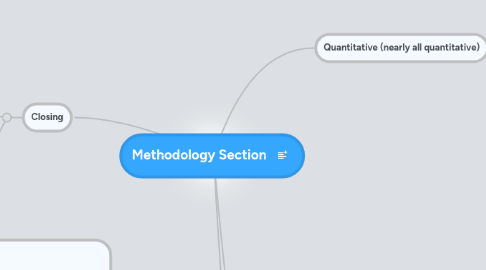
1. Closing
1.1. Restate why this is necessary
1.2. Restate why this study is unique
2. Figure 1. Methodology Overview References Sheppard, A., & Hofmeister, D. (2012). Doctor of education program guide. Southwestern College. Retrieved October 31, 2012, from www.southwesterncollege.org/content/upload/files/Doctor-of-Education-ProgramGuide.pdf
3. Quantitative (nearly all quantitative)
3.1. Research Design
3.1.1. Description
3.1.1.1. 100 days of data examining whether there is a connection between sugar availability within school meals and behavioral incidents.
3.1.2. Rationale
3.1.2.1. Students eat billions of school meals every year. Even the smallest of nutritional components have the potential for a major impact.
3.2. Population and Sample
3.2.1. Description
3.2.1.1. Population is elementary students in the U.S. Sample is students at an elementary building in 2nd-5th grade. Only applicable to students who eat both school breakfast and lunch on a daily basis.
3.2.2. Rationale
3.2.2.1. 2nd-5th grade only because there is an existing data tool that gives precise behavioral data at those grades. Only students who consistently eat both school meals to limit interference from outside food sources.
3.3. Setting and Site Selection
3.3.1. Midwestern elementary school, 2nd-5th grade students, approximately 300 students, Title building. High percentage of low SES and ELL students.
3.4. Instrumentation/Measures/Protocol
3.4.1. Description
3.4.1.1. Attendance: Tardies, absences
3.4.1.2. Meal Consumption: Who ate what
3.4.1.3. Meal Accountability: Exact amounts of food distributed each day
3.4.1.4. Menus: Breakfast, lunch
3.4.1.5. Nutritional Labels: Prepackaged foods
3.4.1.6. Recipes: Foods made on site
3.4.1.7. Conduct Cards: Cards that track behavior for each student
3.4.1.8. Suspension documentation: ISS and OSS incidents
3.4.1.9. Daily Teacher Surveys
3.4.2. Rationale
3.4.2.1. Attendance: If a student is gone for a day, there results need omitted from the study
3.4.2.2. Meal Consumption: Students eating breakfast at home or bringing a sack lunch need excluded
3.4.2.3. Meal Accountability: Just because an item is on the menu doesn't mean every child is eating it. These allow exact numbers for a "typical" meal to be identified.
3.4.2.4. Menus: To determine what all is available at each meal.
3.4.2.5. Nutritional Labels: So sugar grams for each food item can be determined.
3.4.2.6. Recipes: Some items are still prepared in a central kitchen. With the recipe and nutritional labels from all ingredients, sugar quantities for each serving can be determined.
3.4.2.7. Conduct Cards: Give the date and time for specific, minor, behavioral infractions.
3.4.2.8. Suspension Documentation: Gives specifics on all major behavioral infractions.
3.4.2.9. Daily Teacher Surveys: Identify both teacher perceptions of daily behavior and if competitive foods (birthday treats, etc.) were served in the classroom so that data can be excluded when needed.
3.4.3. Procedures
3.4.3.1. Attendance: Already collected by Student Management System
3.4.3.2. Meal Consumption: Already collected by our SMS
3.4.3.3. Meal Accountability: Already required by central kitchen
3.4.3.4. Menus: Already created by central kitchen
3.4.3.5. Nutritional Labels: Readily Available
3.4.3.6. Recipes: Available through central kitchen
3.4.3.7. Conduct Cards: Pre-established behavior system
3.4.3.8. Suspension Documentation: Pre-established behavior documentation
3.4.3.9. Daily Teacher Surveys: Being used by our Wellness Committee to track key data points for future planning. Collected via a Google Form and automatically sent to teachers at the end of each school day.
3.5. Plan for Data
3.5.1. Data will be analyzed for connections between varying levels of sugar availability and behavioral incidents. Exact statistical operations are still pending.
4. Qualitative (small qualitative components)
4.1. Teacher questionnaire
4.1.1. This was established solely for the purposes of this study and will not be administered until after a successful proposal defense. This document will collect teacher perceptions regarding potential connections between nutrition and behavior.
4.2. Daily Teacher Survey
4.2.1. This is qualitative to an extent, but responses are assigned a numerical value...
